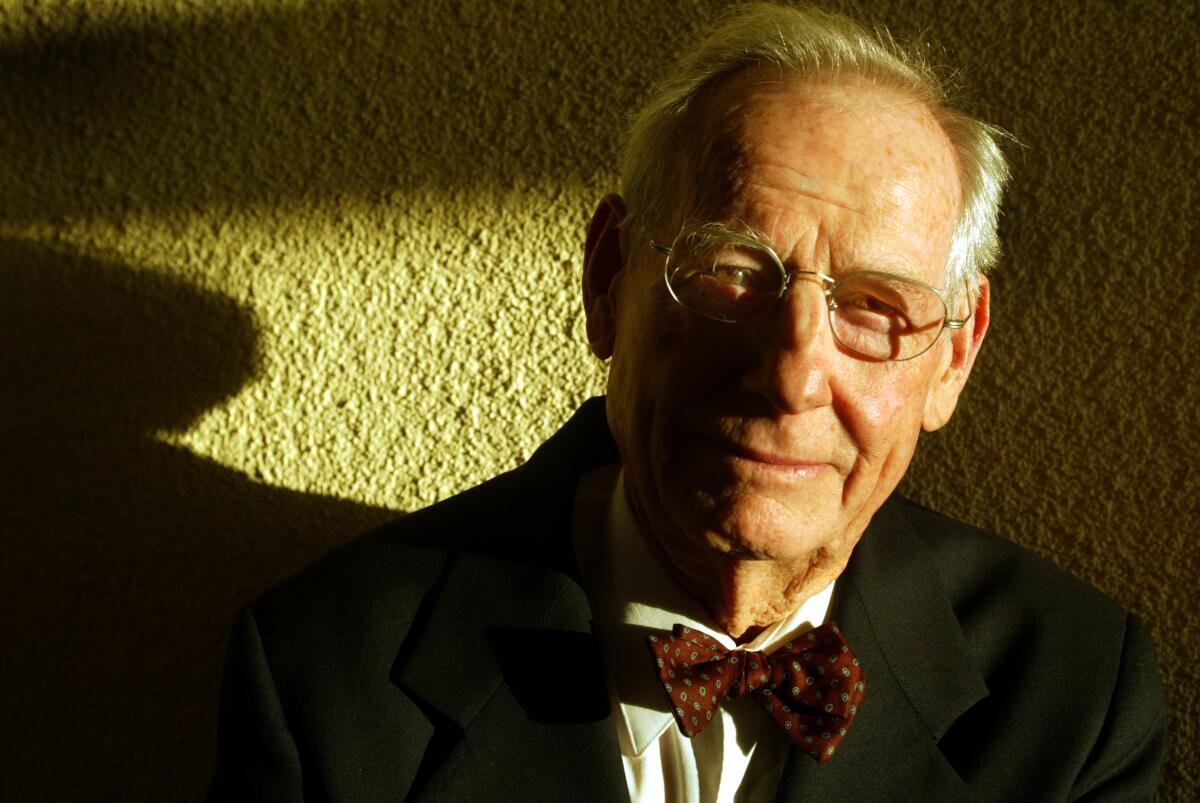Wayne Thiebaud, prolific California painter and teacher, dies at 101

For the record:
12:54 p.m. Dec. 27, 2021An earlier version of this post misspelled Potrero Hill in San Francisco as Portero.
Wayne Thiebaud, an artist whose images of cake, pie and other mass-produced desserts suggested Pop art but whose loose, expressive brush strokes and pointed use of light eventually proved him to be a misunderstood Realist painter, has died. He was 101.
A teacher on the faculty of UC Davis for more than 40 years, Thiebaud died Saturday at his home in Sacramento. His death was confirmed on Instagram by his gallery, Acquavella.
“It is with great sadness that we mark the passing of a truly remarkable man, Wayne Thiebaud,” Acquavella said in a statement.
“An American icon, Wayne led his life with passion and determination, inspired by his love for teaching, tennis, and above all, making art. Even at 101 years old, he still spent most days in the studio, driven by, as he described with his characteristic humility, ‘this almost neurotic fixation of trying to learn to paint.’ It has been an honor to work with you.”
In his memory, the gallery also shared a 2021 quote from Thiebaud deeming art “our saving grace.”
“It can almost ignore our animal premise and spirits,” Thiebaud said.
“It’s worth investing in as many deeply involved people as we can muster because I think that’s where our hopes lie: in giving us a life of pleasure, challenge, comfort, joyousness — all of the things that make us human and able to relate kindly to each other.”
Thiebaud came to fine art after years of experience as a cartoonist, including a brief stint at Walt Disney Studios as a teenager, and commercial artist. His talent for drawing and interest in advertisement art stayed with him.
In the 1950s he began to make oil paintings of bakery goods and children’s toys to capture the “insistent reverie” they evoked for him. Lushly painted cupcakes and gumball machines brought back memories of his idyllic past. “I’m one of those lucky people who had a terrific childhood,” Thiebaud said in a 1995 interview with the San Francisco Chronicle.
His confectionery still lifes with their cheerful disposition seemed to him a misstep, at first.
“When I painted those damned pies I said to myself, ‘This is ridiculous, I’m a respectable painter, I can’t do pies,’“ Thiebaud recalled in a 1985 interview with the San Jose Mercury News. But the sensual beauty of the desserts proved irresistible. “I couldn’t stop,” he said.
He later recalled thinking that he had nothing to lose. He told himself, “Nobody’s going to look at these things anyway, so what the heck,” he said in a 2001 interview with the New York Times.
Fundamentals, including the covert geometry of his compositions and the tactile beauty of his surfaces kept art lovers interested. His first exhibition in New York City, at the Allan Stone gallery, sold out.
“My first reaction to his paintings was, ‘This guy must be nuts,’“ Stone said in a 2002 interview with CBS News. “They were just rows of pies and cakes, and silly looking.”
“After awhile there was a kind of insistence and integrity about them that was undeniable,” Stone said. After the first, sold-out show in 1962, he continued to represent Thiebaud for more than 40 years.
By the early 1960s, Thiebaud’s skill as a draftsman and his attraction to mass-produced items led to comparisons with Pop artists. His pies had something in common with Jasper Johns’ ale cans and Claes Oldenburg’s giant hamburgers.
“Pop art was storming the art world, and Thiebaud’s work was looked upon as a kind of West Coast counterpart to Warhol … and other New York popsters,” art critic Alice Thorson wrote in a 2003 article for the Kansas City Star.
Thiebaud argued that he wasn’t interested, as Pop artists were, in social critique or ironic jokes. He wanted to make paintings calling attention to “things that we’ve overlooked ... those quiet corners of life,” he said in 1986 interview with the Kansas City Star. Birthday cakes and ice cream cones are “terribly important but often don’t seem so in light of an active, electronic society,” he said.
Despite his protests, his name seemed permanently attached to Pop through the 1960s. It wasn’t all bad luck. “Thiebaud’s diner-and-deli still lifes caused him to be misunderstood into fame,” critic Robert Hughes wrote in a 1985 article for Time magazine.
The longer Thiebaud continued to paint, the more the critics agreed with him. He was on a different wavelength. The way he layered paint on a canvas in vibrant strokes and played with variances of light were “the traditional pursuits of a realist painter,” Hughes wrote in 1985.
Thiebaud described his work as primarily a dialogue with artists through history. “I see painting as having its own kind of tradition,” he said in a 1995 interview with the San Francisco Chronicle. “One of commemoration, of layering, of trying to develop into as rich a source of human consciousness ... as possible.”
After a decade of painting still lifes Thiebaud added human figures to his repertoire. “Five Seated Figures,” a painting from 1965, is typical. Two women and three men sit close together but are benignly indifferent to one another. Comparisons to the art of the American Realist painter Edward Hopper followed.
Some critics suggested that the blank expressions on faces in Thiebaud’s art forced the attention back upon the technical aspects of his art. “We begin to realize that Thiebaud has been painting about art, especially realist art,” critic Henry Seldis wrote in a 1977 article for the Los Angeles Times. The detached expressions recall works by the French Realist painter Édouard Manet, Seldis wrote.
In the 1970s Thiebaud became increasingly interested in landscapes and cityscapes that he painted from a bird’s-eye perspective. In “Potrero Hill” a painting from the mid-1970s, he jammed freeways, hills and buildings together in a steep vertical of color and light.
“There is a kind of unrealizable quality about them that has to do with yearning for something beyond, something that I can never reach,” Thiebaud said of his cityscapes in a 1995 interview with the San Francisco Chronicle.
At 80, Thiebaud was the subject of a retrospective exhibition that opened at the Legion of Honor in San Francisco and traveled to the Whitney Museum of Art in New York City. The show confirmed what critics had grappled with for decades.
“Thiebaud has been an anomaly for so long that it hardly seems to matter anymore,” Hughes wrote in his review of the show for Time magazine in 2001.
Thiebaud was born Nov. 15, 1920, in Mesa, Ariz., and moved to Long Beach with his parents in his childhood. He was attending Long Beach Polytechnic High School when he became serious about his interest in cartoon drawing. He worked briefly in the animation department of Walt Disney Studios, where a principal animator drew the first and last frames in a strip and Thiebaud drew the middle frames. He was fired after six months for his pro-union activities.
After graduating from high school he joined the U.S. Army Air Forces and worked as an artist and cartoonist with the Special Services Department. He also worked in the Air Force Motion Picture Unit, based in Culver City.
Discharged from the military, he became an art director and cartoonist for Rexall Drug Co. in Los Angeles. He left the job, went back to school, earned a bachelor of fine arts degree from Cal State Sacramento in 1951 and a master’s degree two years later.
He taught at Sacramento City College through the 1950s and joined the faculty of UC Davis in 1960 and became a professor emeritus in 1991. In later years he contributed more than 20 of his paintings to the school.
As his reputation grew, Thiebaud was given solo exhibits at the San Francisco Museum of Modern Art, the Walker Art Center in Minneapolis and many other museums.
His paintings are included in the permanent collections of the San Francisco Museum of Modern Art, Los Angeles County Museum of Art, Art Institute of Chicago, Museum of Modern Art and the Whitney Museum of American Art in New York City, among others.
Thiebaud married Patricia Patterson in 1943. They had two children before they divorced in 1959. He then married Betty Jean Carr.
He is survived by his daughters, Twinka and Mallary Ann, from his first marriage, and a stepson, Matthew Bult, from his second marriage. His son Paul from his second marriage died of colon cancer in 2010, and his stepson Mark Bult died in 2013.
Rourke is a former Times staff writer.
More to Read
Start your day right
Sign up for Essential California for the L.A. Times biggest news, features and recommendations in your inbox six days a week.
You may occasionally receive promotional content from the Los Angeles Times.






